INF80042 Assignment 4: Technology Essentials for Managers Report
VerifiedAdded on 2023/01/20
|10
|2896
|72
Report
AI Summary
This report, prepared for the INF80042 course, examines technology essentials for managers, focusing on the critical role of IT and IS in driving new strategies and fostering innovation. The report begins by identifying key learnings, such as the ability of IT to enable strategic planning and effective management, and the increasing prevalence of intelligent devices. It also highlights significant challenges, including the frustrations associated with IT implementations and the complexities of managing IT/IS systems. The core of the report is a mind map designed to mentor new graduates, helping them understand the external and internal business environments, and align them with organizational strategic objectives. The mind map emphasizes experiential learning and systems thinking, offering a holistic 360-degree view of the organization, technology, business environment, and market. The report outlines a sequential plan for mentoring, emphasizing understanding the graduate, introducing complexity as a means for higher performance, incorporating a project-oriented approach, experiential learning, and continuous professional development. The report concludes with a discussion of evaluation methods, using employee learning, development, and satisfaction as key performance indicators.
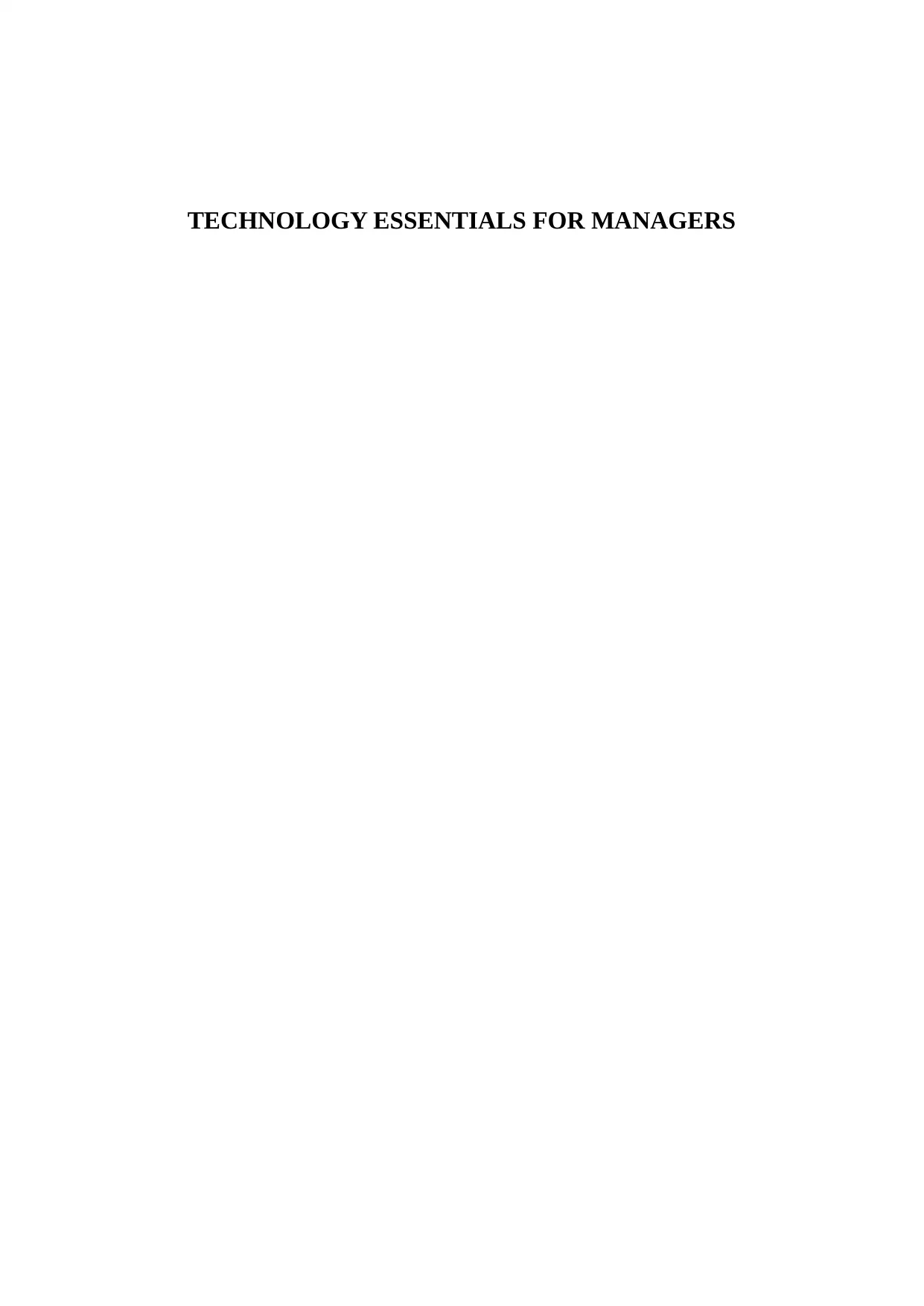
TECHNOLOGY ESSENTIALS FOR MANAGERS
Paraphrase This Document
Need a fresh take? Get an instant paraphrase of this document with our AI Paraphraser
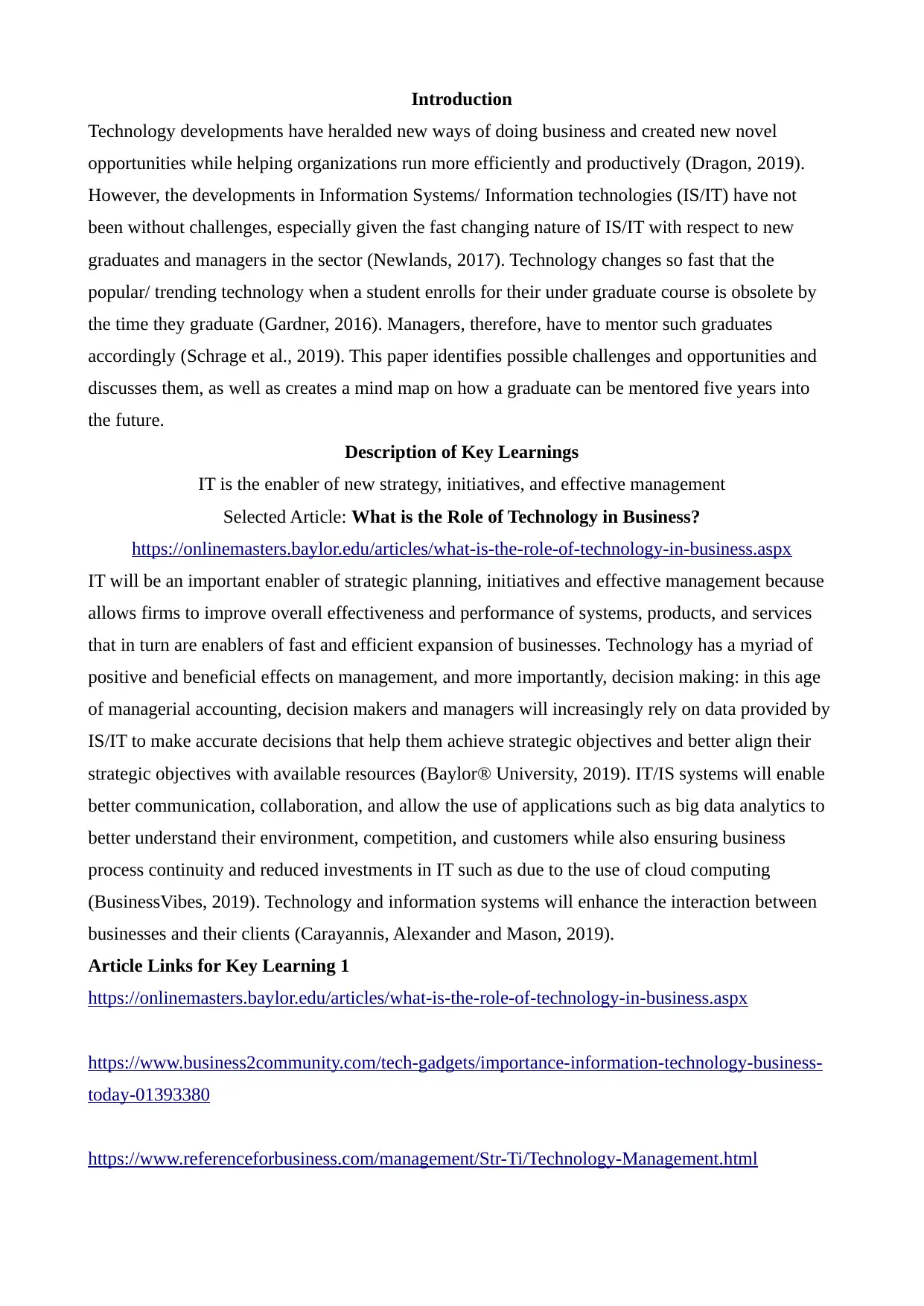
Introduction
Technology developments have heralded new ways of doing business and created new novel
opportunities while helping organizations run more efficiently and productively (Dragon, 2019).
However, the developments in Information Systems/ Information technologies (IS/IT) have not
been without challenges, especially given the fast changing nature of IS/IT with respect to new
graduates and managers in the sector (Newlands, 2017). Technology changes so fast that the
popular/ trending technology when a student enrolls for their under graduate course is obsolete by
the time they graduate (Gardner, 2016). Managers, therefore, have to mentor such graduates
accordingly (Schrage et al., 2019). This paper identifies possible challenges and opportunities and
discusses them, as well as creates a mind map on how a graduate can be mentored five years into
the future.
Description of Key Learnings
IT is the enabler of new strategy, initiatives, and effective management
Selected Article: What is the Role of Technology in Business?
https://onlinemasters.baylor.edu/articles/what-is-the-role-of-technology-in-business.aspx
IT will be an important enabler of strategic planning, initiatives and effective management because
allows firms to improve overall effectiveness and performance of systems, products, and services
that in turn are enablers of fast and efficient expansion of businesses. Technology has a myriad of
positive and beneficial effects on management, and more importantly, decision making: in this age
of managerial accounting, decision makers and managers will increasingly rely on data provided by
IS/IT to make accurate decisions that help them achieve strategic objectives and better align their
strategic objectives with available resources (Baylor® University, 2019). IT/IS systems will enable
better communication, collaboration, and allow the use of applications such as big data analytics to
better understand their environment, competition, and customers while also ensuring business
process continuity and reduced investments in IT such as due to the use of cloud computing
(BusinessVibes, 2019). Technology and information systems will enhance the interaction between
businesses and their clients (Carayannis, Alexander and Mason, 2019).
Article Links for Key Learning 1
https://onlinemasters.baylor.edu/articles/what-is-the-role-of-technology-in-business.aspx
https://www.business2community.com/tech-gadgets/importance-information-technology-business-
today-01393380
https://www.referenceforbusiness.com/management/Str-Ti/Technology-Management.html
Technology developments have heralded new ways of doing business and created new novel
opportunities while helping organizations run more efficiently and productively (Dragon, 2019).
However, the developments in Information Systems/ Information technologies (IS/IT) have not
been without challenges, especially given the fast changing nature of IS/IT with respect to new
graduates and managers in the sector (Newlands, 2017). Technology changes so fast that the
popular/ trending technology when a student enrolls for their under graduate course is obsolete by
the time they graduate (Gardner, 2016). Managers, therefore, have to mentor such graduates
accordingly (Schrage et al., 2019). This paper identifies possible challenges and opportunities and
discusses them, as well as creates a mind map on how a graduate can be mentored five years into
the future.
Description of Key Learnings
IT is the enabler of new strategy, initiatives, and effective management
Selected Article: What is the Role of Technology in Business?
https://onlinemasters.baylor.edu/articles/what-is-the-role-of-technology-in-business.aspx
IT will be an important enabler of strategic planning, initiatives and effective management because
allows firms to improve overall effectiveness and performance of systems, products, and services
that in turn are enablers of fast and efficient expansion of businesses. Technology has a myriad of
positive and beneficial effects on management, and more importantly, decision making: in this age
of managerial accounting, decision makers and managers will increasingly rely on data provided by
IS/IT to make accurate decisions that help them achieve strategic objectives and better align their
strategic objectives with available resources (Baylor® University, 2019). IT/IS systems will enable
better communication, collaboration, and allow the use of applications such as big data analytics to
better understand their environment, competition, and customers while also ensuring business
process continuity and reduced investments in IT such as due to the use of cloud computing
(BusinessVibes, 2019). Technology and information systems will enhance the interaction between
businesses and their clients (Carayannis, Alexander and Mason, 2019).
Article Links for Key Learning 1
https://onlinemasters.baylor.edu/articles/what-is-the-role-of-technology-in-business.aspx
https://www.business2community.com/tech-gadgets/importance-information-technology-business-
today-01393380
https://www.referenceforbusiness.com/management/Str-Ti/Technology-Management.html
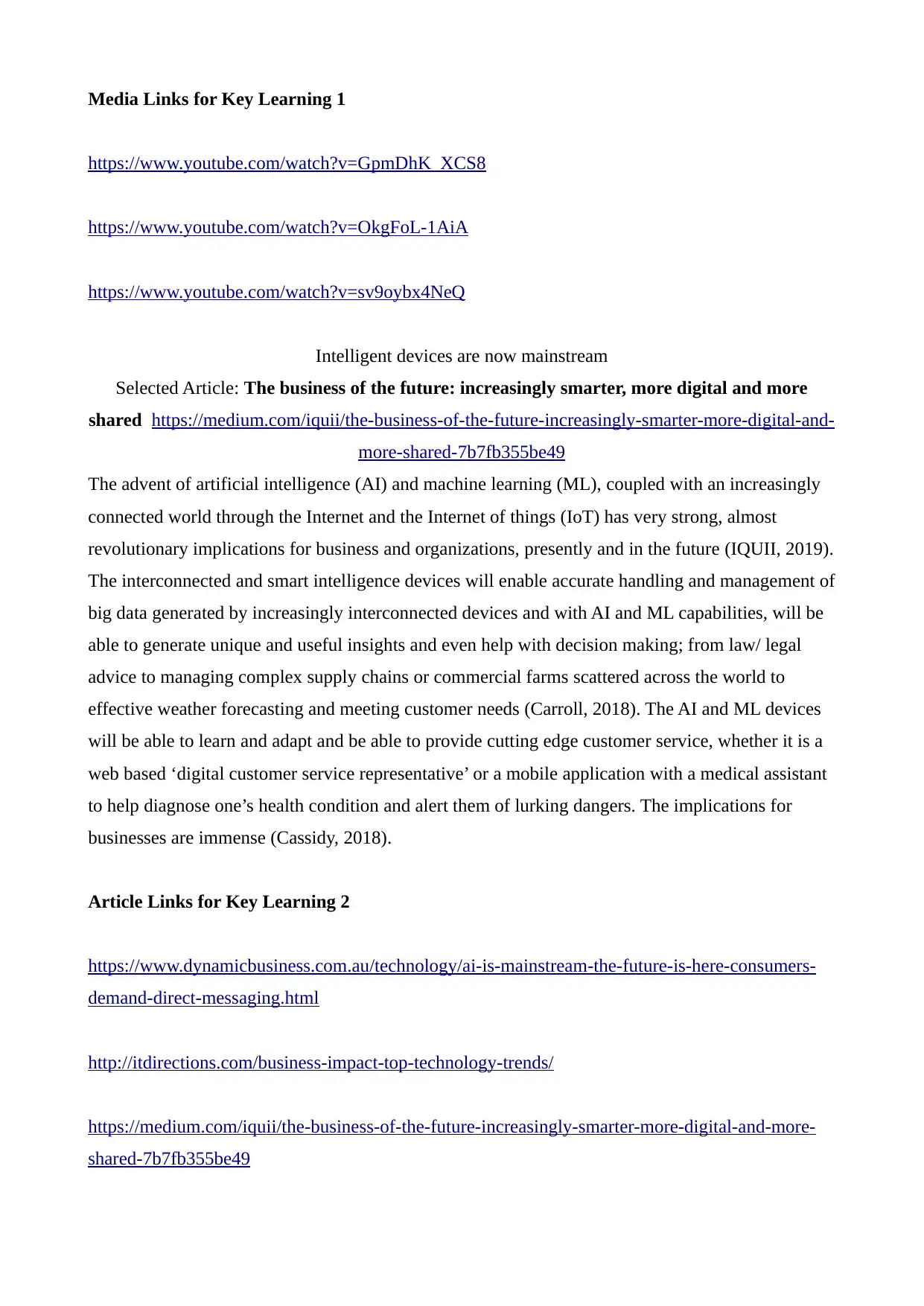
Media Links for Key Learning 1
https://www.youtube.com/watch?v=GpmDhK_XCS8
https://www.youtube.com/watch?v=OkgFoL-1AiA
https://www.youtube.com/watch?v=sv9oybx4NeQ
Intelligent devices are now mainstream
Selected Article: The business of the future: increasingly smarter, more digital and more
shared https://medium.com/iquii/the-business-of-the-future-increasingly-smarter-more-digital-and-
more-shared-7b7fb355be49
The advent of artificial intelligence (AI) and machine learning (ML), coupled with an increasingly
connected world through the Internet and the Internet of things (IoT) has very strong, almost
revolutionary implications for business and organizations, presently and in the future (IQUII, 2019).
The interconnected and smart intelligence devices will enable accurate handling and management of
big data generated by increasingly interconnected devices and with AI and ML capabilities, will be
able to generate unique and useful insights and even help with decision making; from law/ legal
advice to managing complex supply chains or commercial farms scattered across the world to
effective weather forecasting and meeting customer needs (Carroll, 2018). The AI and ML devices
will be able to learn and adapt and be able to provide cutting edge customer service, whether it is a
web based ‘digital customer service representative’ or a mobile application with a medical assistant
to help diagnose one’s health condition and alert them of lurking dangers. The implications for
businesses are immense (Cassidy, 2018).
Article Links for Key Learning 2
https://www.dynamicbusiness.com.au/technology/ai-is-mainstream-the-future-is-here-consumers-
demand-direct-messaging.html
http://itdirections.com/business-impact-top-technology-trends/
https://medium.com/iquii/the-business-of-the-future-increasingly-smarter-more-digital-and-more-
shared-7b7fb355be49
https://www.youtube.com/watch?v=GpmDhK_XCS8
https://www.youtube.com/watch?v=OkgFoL-1AiA
https://www.youtube.com/watch?v=sv9oybx4NeQ
Intelligent devices are now mainstream
Selected Article: The business of the future: increasingly smarter, more digital and more
shared https://medium.com/iquii/the-business-of-the-future-increasingly-smarter-more-digital-and-
more-shared-7b7fb355be49
The advent of artificial intelligence (AI) and machine learning (ML), coupled with an increasingly
connected world through the Internet and the Internet of things (IoT) has very strong, almost
revolutionary implications for business and organizations, presently and in the future (IQUII, 2019).
The interconnected and smart intelligence devices will enable accurate handling and management of
big data generated by increasingly interconnected devices and with AI and ML capabilities, will be
able to generate unique and useful insights and even help with decision making; from law/ legal
advice to managing complex supply chains or commercial farms scattered across the world to
effective weather forecasting and meeting customer needs (Carroll, 2018). The AI and ML devices
will be able to learn and adapt and be able to provide cutting edge customer service, whether it is a
web based ‘digital customer service representative’ or a mobile application with a medical assistant
to help diagnose one’s health condition and alert them of lurking dangers. The implications for
businesses are immense (Cassidy, 2018).
Article Links for Key Learning 2
https://www.dynamicbusiness.com.au/technology/ai-is-mainstream-the-future-is-here-consumers-
demand-direct-messaging.html
http://itdirections.com/business-impact-top-technology-trends/
https://medium.com/iquii/the-business-of-the-future-increasingly-smarter-more-digital-and-more-
shared-7b7fb355be49
⊘ This is a preview!⊘
Do you want full access?
Subscribe today to unlock all pages.

Trusted by 1+ million students worldwide
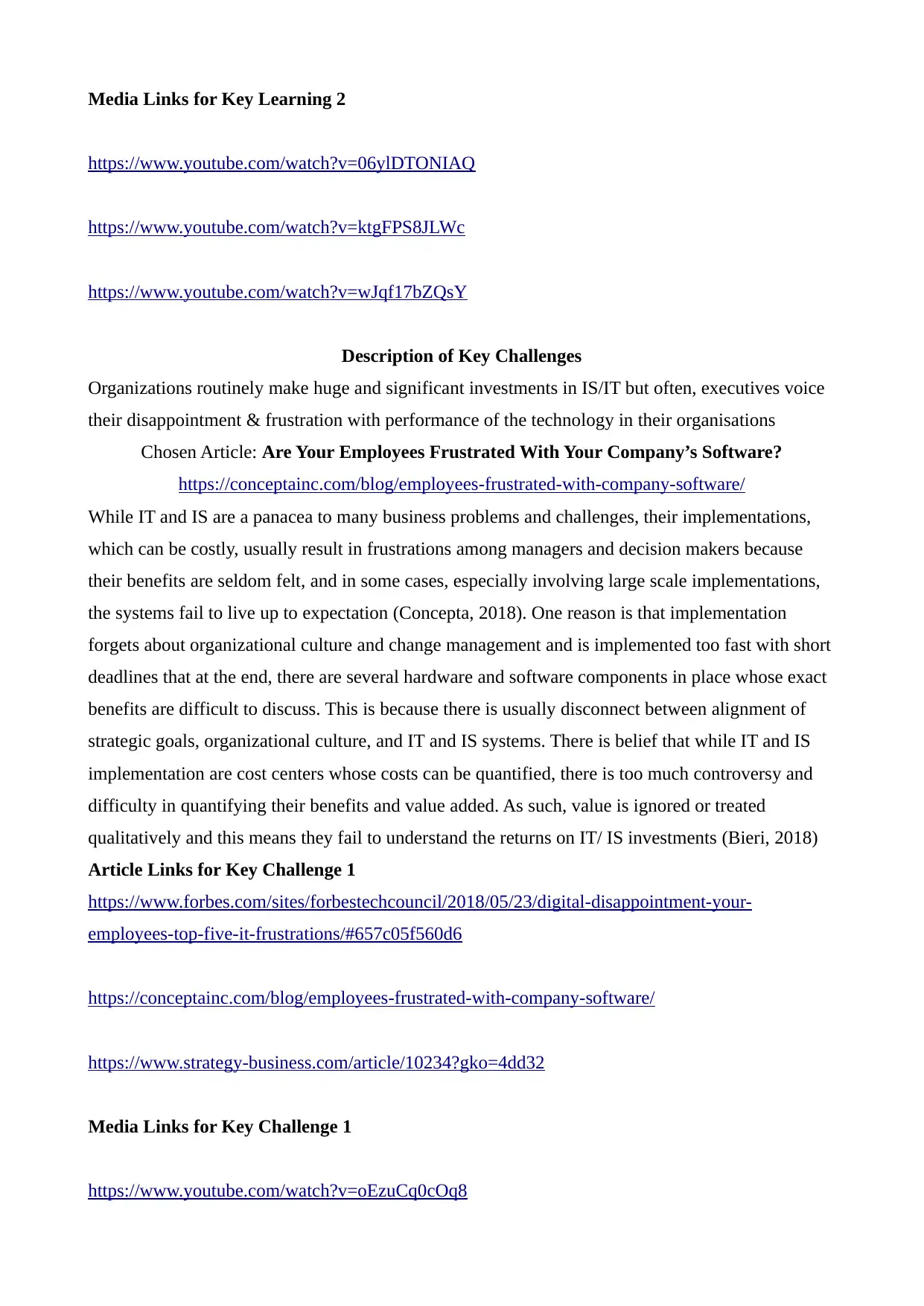
Media Links for Key Learning 2
https://www.youtube.com/watch?v=06ylDTONIAQ
https://www.youtube.com/watch?v=ktgFPS8JLWc
https://www.youtube.com/watch?v=wJqf17bZQsY
Description of Key Challenges
Organizations routinely make huge and significant investments in IS/IT but often, executives voice
their disappointment & frustration with performance of the technology in their organisations
Chosen Article: Are Your Employees Frustrated With Your Company’s Software?
https://conceptainc.com/blog/employees-frustrated-with-company-software/
While IT and IS are a panacea to many business problems and challenges, their implementations,
which can be costly, usually result in frustrations among managers and decision makers because
their benefits are seldom felt, and in some cases, especially involving large scale implementations,
the systems fail to live up to expectation (Concepta, 2018). One reason is that implementation
forgets about organizational culture and change management and is implemented too fast with short
deadlines that at the end, there are several hardware and software components in place whose exact
benefits are difficult to discuss. This is because there is usually disconnect between alignment of
strategic goals, organizational culture, and IT and IS systems. There is belief that while IT and IS
implementation are cost centers whose costs can be quantified, there is too much controversy and
difficulty in quantifying their benefits and value added. As such, value is ignored or treated
qualitatively and this means they fail to understand the returns on IT/ IS investments (Bieri, 2018)
Article Links for Key Challenge 1
https://www.forbes.com/sites/forbestechcouncil/2018/05/23/digital-disappointment-your-
employees-top-five-it-frustrations/#657c05f560d6
https://conceptainc.com/blog/employees-frustrated-with-company-software/
https://www.strategy-business.com/article/10234?gko=4dd32
Media Links for Key Challenge 1
https://www.youtube.com/watch?v=oEzuCq0cOq8
https://www.youtube.com/watch?v=06ylDTONIAQ
https://www.youtube.com/watch?v=ktgFPS8JLWc
https://www.youtube.com/watch?v=wJqf17bZQsY
Description of Key Challenges
Organizations routinely make huge and significant investments in IS/IT but often, executives voice
their disappointment & frustration with performance of the technology in their organisations
Chosen Article: Are Your Employees Frustrated With Your Company’s Software?
https://conceptainc.com/blog/employees-frustrated-with-company-software/
While IT and IS are a panacea to many business problems and challenges, their implementations,
which can be costly, usually result in frustrations among managers and decision makers because
their benefits are seldom felt, and in some cases, especially involving large scale implementations,
the systems fail to live up to expectation (Concepta, 2018). One reason is that implementation
forgets about organizational culture and change management and is implemented too fast with short
deadlines that at the end, there are several hardware and software components in place whose exact
benefits are difficult to discuss. This is because there is usually disconnect between alignment of
strategic goals, organizational culture, and IT and IS systems. There is belief that while IT and IS
implementation are cost centers whose costs can be quantified, there is too much controversy and
difficulty in quantifying their benefits and value added. As such, value is ignored or treated
qualitatively and this means they fail to understand the returns on IT/ IS investments (Bieri, 2018)
Article Links for Key Challenge 1
https://www.forbes.com/sites/forbestechcouncil/2018/05/23/digital-disappointment-your-
employees-top-five-it-frustrations/#657c05f560d6
https://conceptainc.com/blog/employees-frustrated-with-company-software/
https://www.strategy-business.com/article/10234?gko=4dd32
Media Links for Key Challenge 1
https://www.youtube.com/watch?v=oEzuCq0cOq8
Paraphrase This Document
Need a fresh take? Get an instant paraphrase of this document with our AI Paraphraser
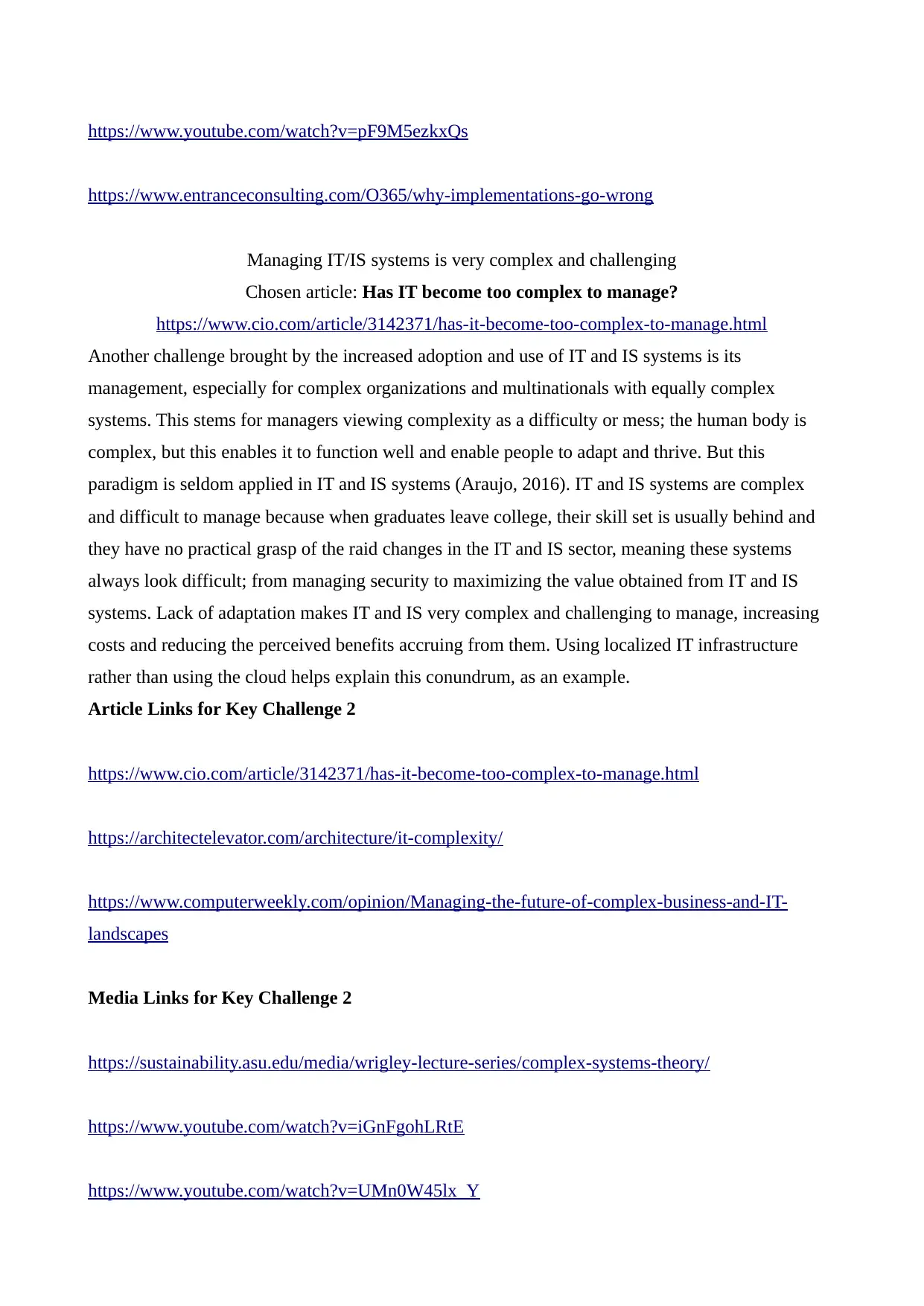
https://www.youtube.com/watch?v=pF9M5ezkxQs
https://www.entranceconsulting.com/O365/why-implementations-go-wrong
Managing IT/IS systems is very complex and challenging
Chosen article: Has IT become too complex to manage?
https://www.cio.com/article/3142371/has-it-become-too-complex-to-manage.html
Another challenge brought by the increased adoption and use of IT and IS systems is its
management, especially for complex organizations and multinationals with equally complex
systems. This stems for managers viewing complexity as a difficulty or mess; the human body is
complex, but this enables it to function well and enable people to adapt and thrive. But this
paradigm is seldom applied in IT and IS systems (Araujo, 2016). IT and IS systems are complex
and difficult to manage because when graduates leave college, their skill set is usually behind and
they have no practical grasp of the raid changes in the IT and IS sector, meaning these systems
always look difficult; from managing security to maximizing the value obtained from IT and IS
systems. Lack of adaptation makes IT and IS very complex and challenging to manage, increasing
costs and reducing the perceived benefits accruing from them. Using localized IT infrastructure
rather than using the cloud helps explain this conundrum, as an example.
Article Links for Key Challenge 2
https://www.cio.com/article/3142371/has-it-become-too-complex-to-manage.html
https://architectelevator.com/architecture/it-complexity/
https://www.computerweekly.com/opinion/Managing-the-future-of-complex-business-and-IT-
landscapes
Media Links for Key Challenge 2
https://sustainability.asu.edu/media/wrigley-lecture-series/complex-systems-theory/
https://www.youtube.com/watch?v=iGnFgohLRtE
https://www.youtube.com/watch?v=UMn0W45lx_Y
https://www.entranceconsulting.com/O365/why-implementations-go-wrong
Managing IT/IS systems is very complex and challenging
Chosen article: Has IT become too complex to manage?
https://www.cio.com/article/3142371/has-it-become-too-complex-to-manage.html
Another challenge brought by the increased adoption and use of IT and IS systems is its
management, especially for complex organizations and multinationals with equally complex
systems. This stems for managers viewing complexity as a difficulty or mess; the human body is
complex, but this enables it to function well and enable people to adapt and thrive. But this
paradigm is seldom applied in IT and IS systems (Araujo, 2016). IT and IS systems are complex
and difficult to manage because when graduates leave college, their skill set is usually behind and
they have no practical grasp of the raid changes in the IT and IS sector, meaning these systems
always look difficult; from managing security to maximizing the value obtained from IT and IS
systems. Lack of adaptation makes IT and IS very complex and challenging to manage, increasing
costs and reducing the perceived benefits accruing from them. Using localized IT infrastructure
rather than using the cloud helps explain this conundrum, as an example.
Article Links for Key Challenge 2
https://www.cio.com/article/3142371/has-it-become-too-complex-to-manage.html
https://architectelevator.com/architecture/it-complexity/
https://www.computerweekly.com/opinion/Managing-the-future-of-complex-business-and-IT-
landscapes
Media Links for Key Challenge 2
https://sustainability.asu.edu/media/wrigley-lecture-series/complex-systems-theory/
https://www.youtube.com/watch?v=iGnFgohLRtE
https://www.youtube.com/watch?v=UMn0W45lx_Y
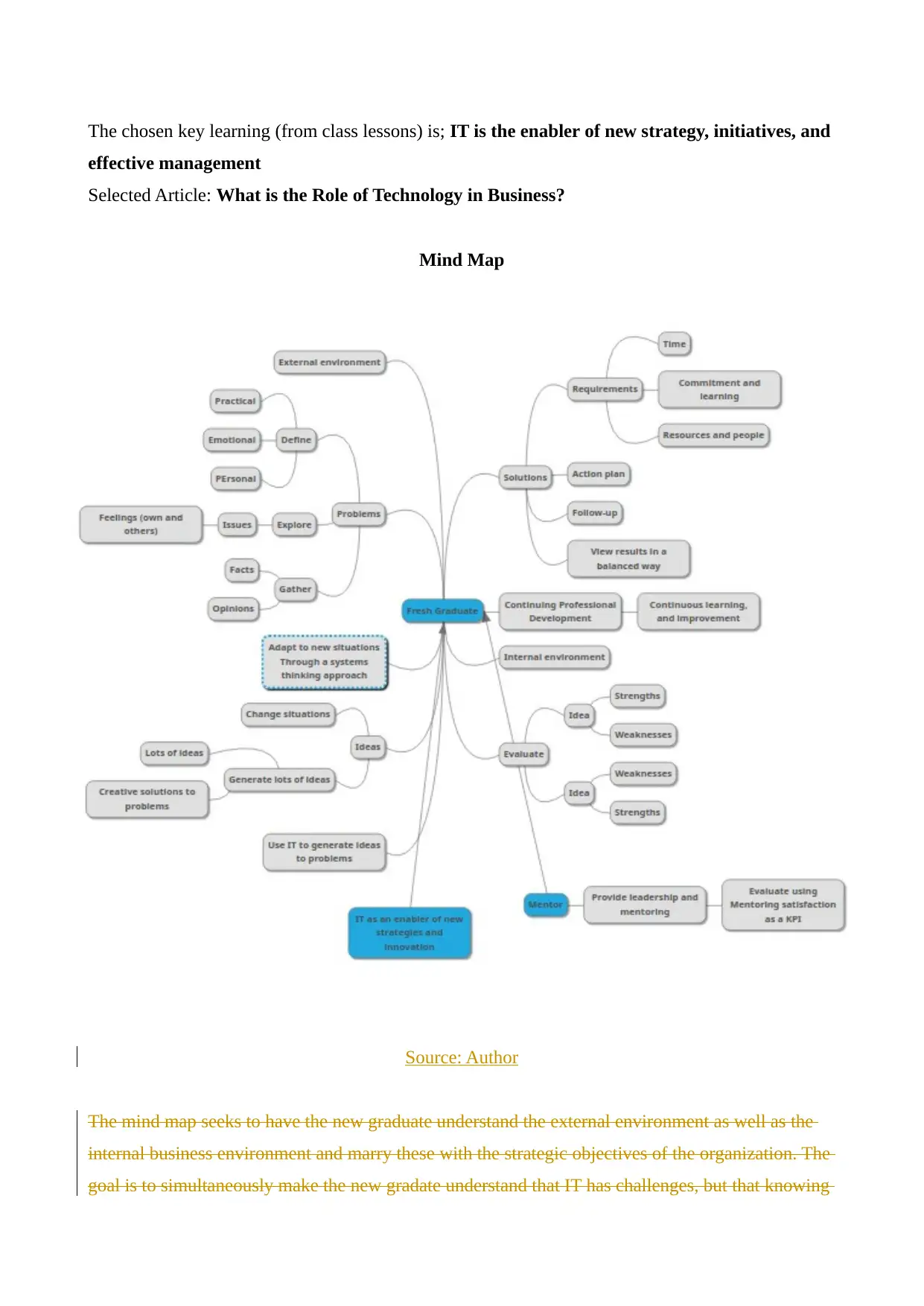
The chosen key learning (from class lessons) is; IT is the enabler of new strategy, initiatives, and
effective management
Selected Article: What is the Role of Technology in Business?
Mind Map
Source: Author
The mind map seeks to have the new graduate understand the external environment as well as the
internal business environment and marry these with the strategic objectives of the organization. The
goal is to simultaneously make the new gradate understand that IT has challenges, but that knowing
effective management
Selected Article: What is the Role of Technology in Business?
Mind Map
Source: Author
The mind map seeks to have the new graduate understand the external environment as well as the
internal business environment and marry these with the strategic objectives of the organization. The
goal is to simultaneously make the new gradate understand that IT has challenges, but that knowing
⊘ This is a preview!⊘
Do you want full access?
Subscribe today to unlock all pages.

Trusted by 1+ million students worldwide
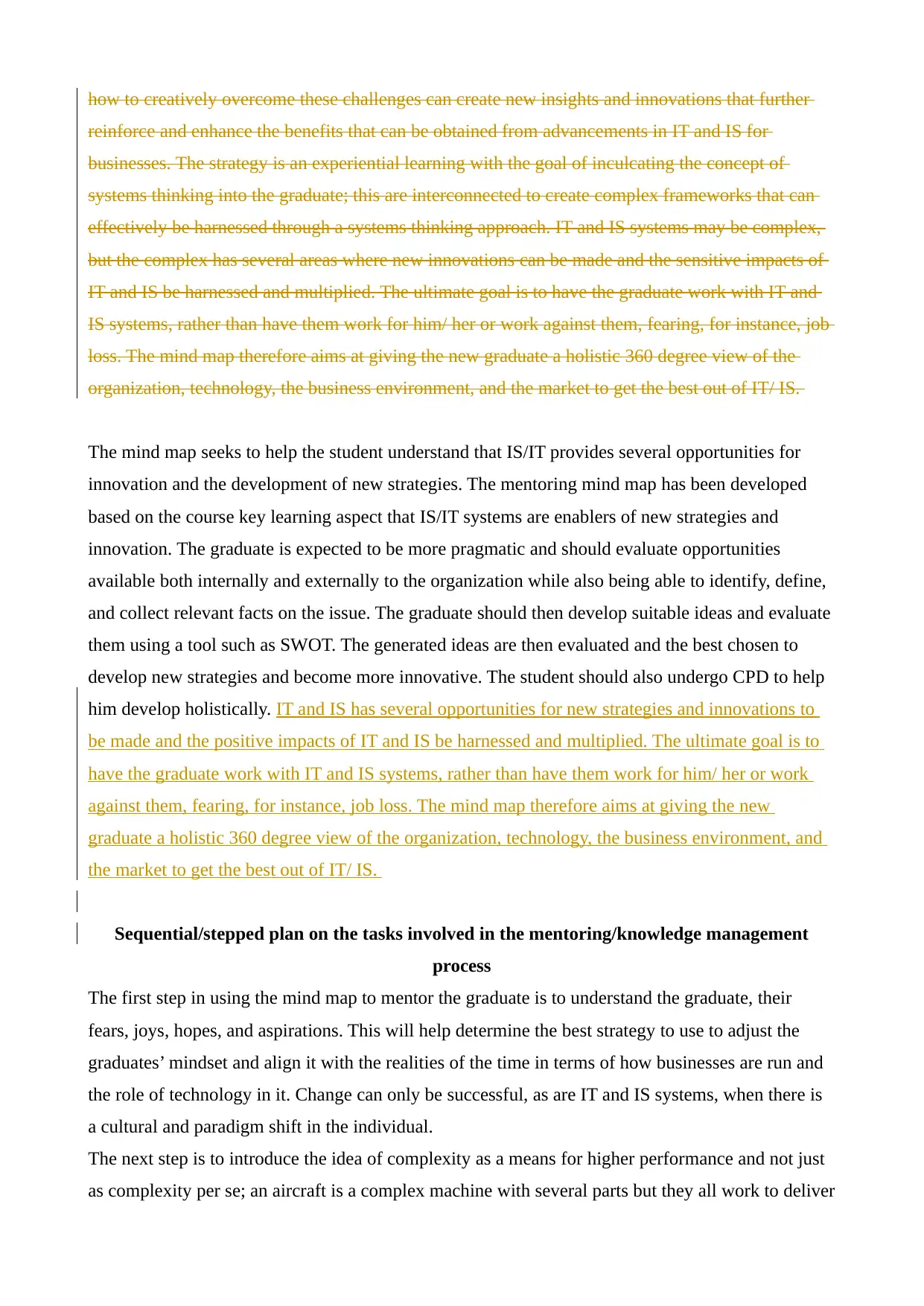
how to creatively overcome these challenges can create new insights and innovations that further
reinforce and enhance the benefits that can be obtained from advancements in IT and IS for
businesses. The strategy is an experiential learning with the goal of inculcating the concept of
systems thinking into the graduate; this are interconnected to create complex frameworks that can
effectively be harnessed through a systems thinking approach. IT and IS systems may be complex,
but the complex has several areas where new innovations can be made and the sensitive impacts of
IT and IS be harnessed and multiplied. The ultimate goal is to have the graduate work with IT and
IS systems, rather than have them work for him/ her or work against them, fearing, for instance, job
loss. The mind map therefore aims at giving the new graduate a holistic 360 degree view of the
organization, technology, the business environment, and the market to get the best out of IT/ IS.
The mind map seeks to help the student understand that IS/IT provides several opportunities for
innovation and the development of new strategies. The mentoring mind map has been developed
based on the course key learning aspect that IS/IT systems are enablers of new strategies and
innovation. The graduate is expected to be more pragmatic and should evaluate opportunities
available both internally and externally to the organization while also being able to identify, define,
and collect relevant facts on the issue. The graduate should then develop suitable ideas and evaluate
them using a tool such as SWOT. The generated ideas are then evaluated and the best chosen to
develop new strategies and become more innovative. The student should also undergo CPD to help
him develop holistically. IT and IS has several opportunities for new strategies and innovations to
be made and the positive impacts of IT and IS be harnessed and multiplied. The ultimate goal is to
have the graduate work with IT and IS systems, rather than have them work for him/ her or work
against them, fearing, for instance, job loss. The mind map therefore aims at giving the new
graduate a holistic 360 degree view of the organization, technology, the business environment, and
the market to get the best out of IT/ IS.
Sequential/stepped plan on the tasks involved in the mentoring/knowledge management
process
The first step in using the mind map to mentor the graduate is to understand the graduate, their
fears, joys, hopes, and aspirations. This will help determine the best strategy to use to adjust the
graduates’ mindset and align it with the realities of the time in terms of how businesses are run and
the role of technology in it. Change can only be successful, as are IT and IS systems, when there is
a cultural and paradigm shift in the individual.
The next step is to introduce the idea of complexity as a means for higher performance and not just
as complexity per se; an aircraft is a complex machine with several parts but they all work to deliver
reinforce and enhance the benefits that can be obtained from advancements in IT and IS for
businesses. The strategy is an experiential learning with the goal of inculcating the concept of
systems thinking into the graduate; this are interconnected to create complex frameworks that can
effectively be harnessed through a systems thinking approach. IT and IS systems may be complex,
but the complex has several areas where new innovations can be made and the sensitive impacts of
IT and IS be harnessed and multiplied. The ultimate goal is to have the graduate work with IT and
IS systems, rather than have them work for him/ her or work against them, fearing, for instance, job
loss. The mind map therefore aims at giving the new graduate a holistic 360 degree view of the
organization, technology, the business environment, and the market to get the best out of IT/ IS.
The mind map seeks to help the student understand that IS/IT provides several opportunities for
innovation and the development of new strategies. The mentoring mind map has been developed
based on the course key learning aspect that IS/IT systems are enablers of new strategies and
innovation. The graduate is expected to be more pragmatic and should evaluate opportunities
available both internally and externally to the organization while also being able to identify, define,
and collect relevant facts on the issue. The graduate should then develop suitable ideas and evaluate
them using a tool such as SWOT. The generated ideas are then evaluated and the best chosen to
develop new strategies and become more innovative. The student should also undergo CPD to help
him develop holistically. IT and IS has several opportunities for new strategies and innovations to
be made and the positive impacts of IT and IS be harnessed and multiplied. The ultimate goal is to
have the graduate work with IT and IS systems, rather than have them work for him/ her or work
against them, fearing, for instance, job loss. The mind map therefore aims at giving the new
graduate a holistic 360 degree view of the organization, technology, the business environment, and
the market to get the best out of IT/ IS.
Sequential/stepped plan on the tasks involved in the mentoring/knowledge management
process
The first step in using the mind map to mentor the graduate is to understand the graduate, their
fears, joys, hopes, and aspirations. This will help determine the best strategy to use to adjust the
graduates’ mindset and align it with the realities of the time in terms of how businesses are run and
the role of technology in it. Change can only be successful, as are IT and IS systems, when there is
a cultural and paradigm shift in the individual.
The next step is to introduce the idea of complexity as a means for higher performance and not just
as complexity per se; an aircraft is a complex machine with several parts but they all work to deliver
Paraphrase This Document
Need a fresh take? Get an instant paraphrase of this document with our AI Paraphraser
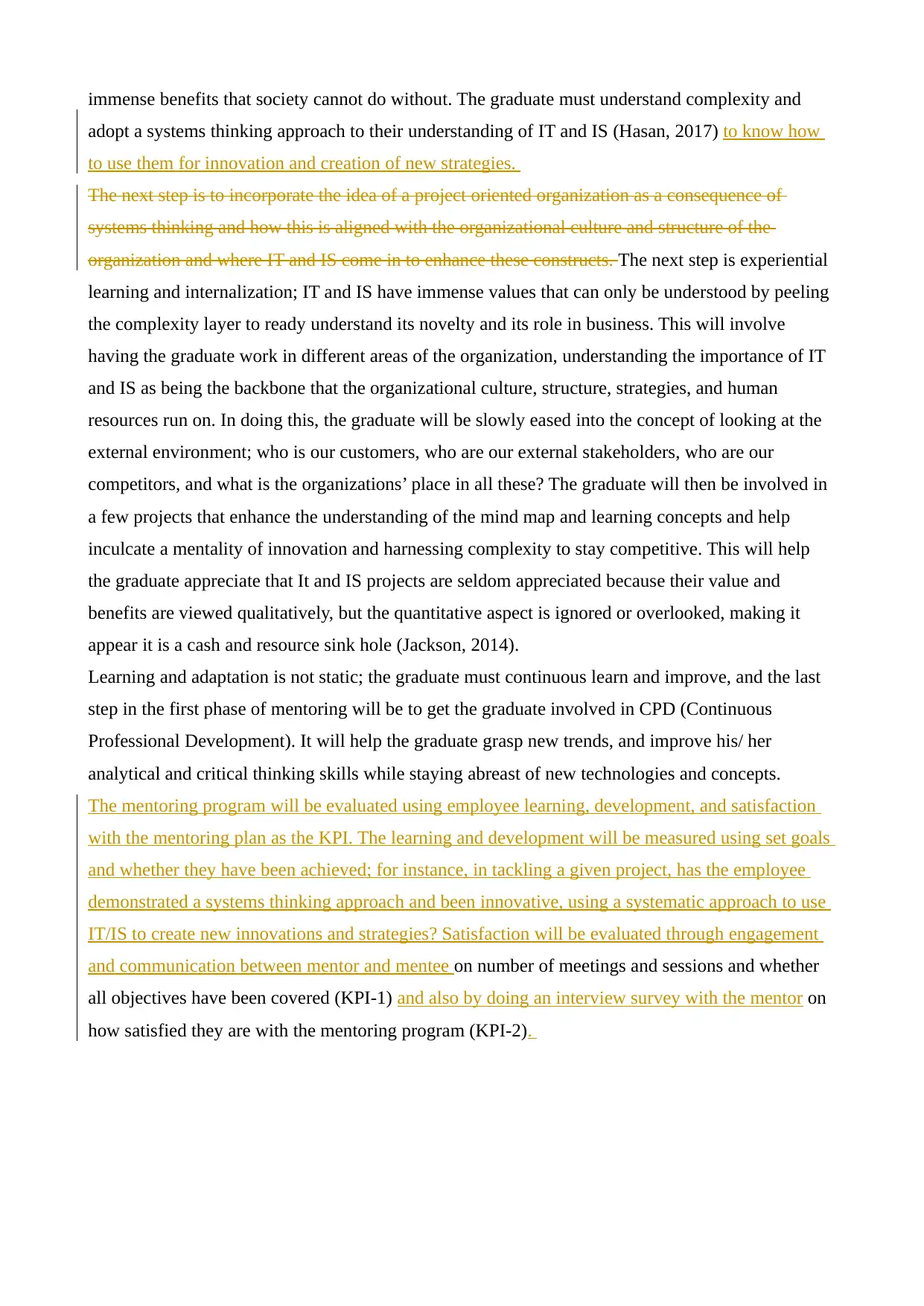
immense benefits that society cannot do without. The graduate must understand complexity and
adopt a systems thinking approach to their understanding of IT and IS (Hasan, 2017) to know how
to use them for innovation and creation of new strategies.
The next step is to incorporate the idea of a project oriented organization as a consequence of
systems thinking and how this is aligned with the organizational culture and structure of the
organization and where IT and IS come in to enhance these constructs. The next step is experiential
learning and internalization; IT and IS have immense values that can only be understood by peeling
the complexity layer to ready understand its novelty and its role in business. This will involve
having the graduate work in different areas of the organization, understanding the importance of IT
and IS as being the backbone that the organizational culture, structure, strategies, and human
resources run on. In doing this, the graduate will be slowly eased into the concept of looking at the
external environment; who is our customers, who are our external stakeholders, who are our
competitors, and what is the organizations’ place in all these? The graduate will then be involved in
a few projects that enhance the understanding of the mind map and learning concepts and help
inculcate a mentality of innovation and harnessing complexity to stay competitive. This will help
the graduate appreciate that It and IS projects are seldom appreciated because their value and
benefits are viewed qualitatively, but the quantitative aspect is ignored or overlooked, making it
appear it is a cash and resource sink hole (Jackson, 2014).
Learning and adaptation is not static; the graduate must continuous learn and improve, and the last
step in the first phase of mentoring will be to get the graduate involved in CPD (Continuous
Professional Development). It will help the graduate grasp new trends, and improve his/ her
analytical and critical thinking skills while staying abreast of new technologies and concepts.
The mentoring program will be evaluated using employee learning, development, and satisfaction
with the mentoring plan as the KPI. The learning and development will be measured using set goals
and whether they have been achieved; for instance, in tackling a given project, has the employee
demonstrated a systems thinking approach and been innovative, using a systematic approach to use
IT/IS to create new innovations and strategies? Satisfaction will be evaluated through engagement
and communication between mentor and mentee on number of meetings and sessions and whether
all objectives have been covered (KPI-1) and also by doing an interview survey with the mentor on
how satisfied they are with the mentoring program (KPI-2).
adopt a systems thinking approach to their understanding of IT and IS (Hasan, 2017) to know how
to use them for innovation and creation of new strategies.
The next step is to incorporate the idea of a project oriented organization as a consequence of
systems thinking and how this is aligned with the organizational culture and structure of the
organization and where IT and IS come in to enhance these constructs. The next step is experiential
learning and internalization; IT and IS have immense values that can only be understood by peeling
the complexity layer to ready understand its novelty and its role in business. This will involve
having the graduate work in different areas of the organization, understanding the importance of IT
and IS as being the backbone that the organizational culture, structure, strategies, and human
resources run on. In doing this, the graduate will be slowly eased into the concept of looking at the
external environment; who is our customers, who are our external stakeholders, who are our
competitors, and what is the organizations’ place in all these? The graduate will then be involved in
a few projects that enhance the understanding of the mind map and learning concepts and help
inculcate a mentality of innovation and harnessing complexity to stay competitive. This will help
the graduate appreciate that It and IS projects are seldom appreciated because their value and
benefits are viewed qualitatively, but the quantitative aspect is ignored or overlooked, making it
appear it is a cash and resource sink hole (Jackson, 2014).
Learning and adaptation is not static; the graduate must continuous learn and improve, and the last
step in the first phase of mentoring will be to get the graduate involved in CPD (Continuous
Professional Development). It will help the graduate grasp new trends, and improve his/ her
analytical and critical thinking skills while staying abreast of new technologies and concepts.
The mentoring program will be evaluated using employee learning, development, and satisfaction
with the mentoring plan as the KPI. The learning and development will be measured using set goals
and whether they have been achieved; for instance, in tackling a given project, has the employee
demonstrated a systems thinking approach and been innovative, using a systematic approach to use
IT/IS to create new innovations and strategies? Satisfaction will be evaluated through engagement
and communication between mentor and mentee on number of meetings and sessions and whether
all objectives have been covered (KPI-1) and also by doing an interview survey with the mentor on
how satisfied they are with the mentoring program (KPI-2).
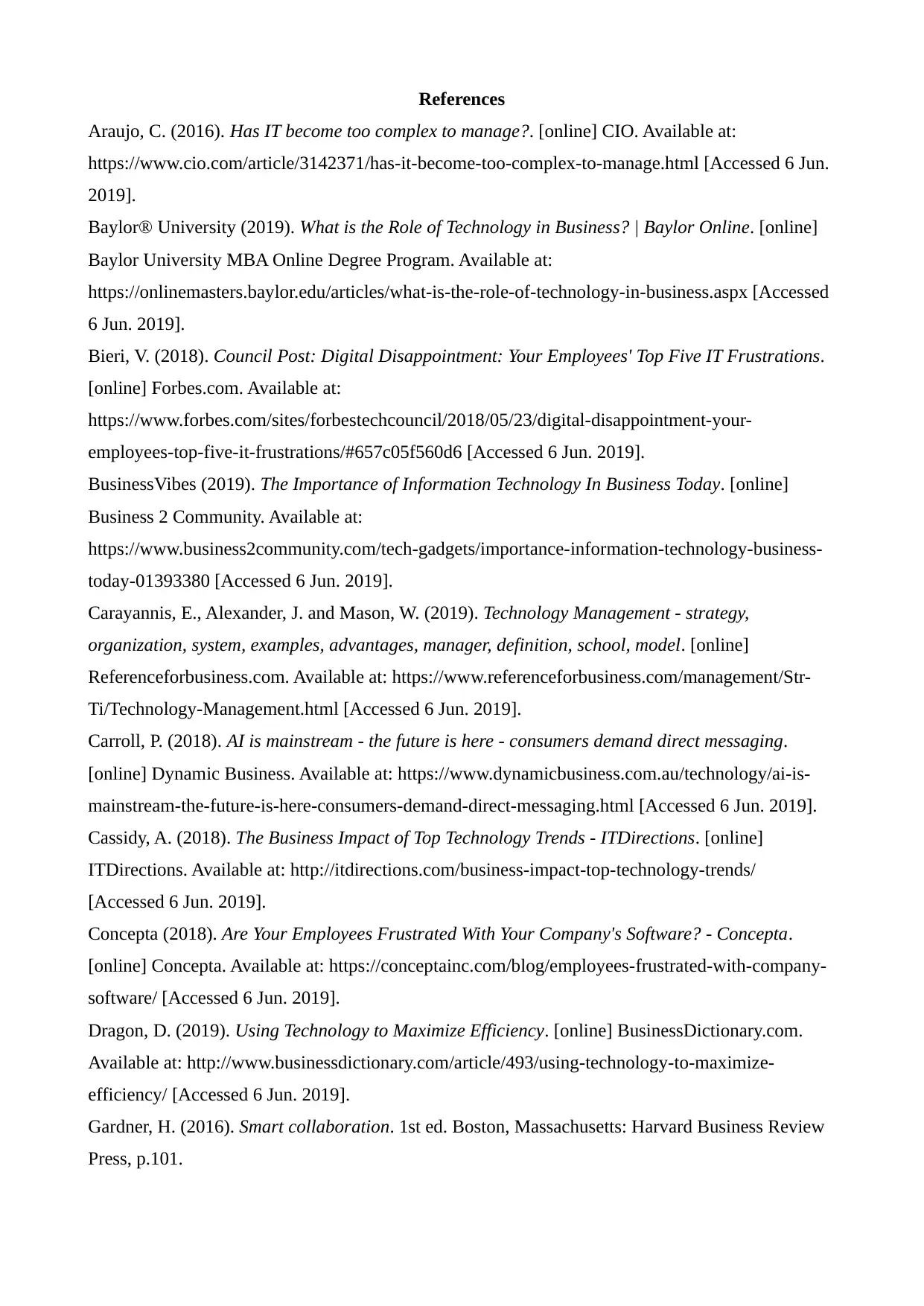
References
Araujo, C. (2016). Has IT become too complex to manage?. [online] CIO. Available at:
https://www.cio.com/article/3142371/has-it-become-too-complex-to-manage.html [Accessed 6 Jun.
2019].
Baylor® University (2019). What is the Role of Technology in Business? | Baylor Online. [online]
Baylor University MBA Online Degree Program. Available at:
https://onlinemasters.baylor.edu/articles/what-is-the-role-of-technology-in-business.aspx [Accessed
6 Jun. 2019].
Bieri, V. (2018). Council Post: Digital Disappointment: Your Employees' Top Five IT Frustrations.
[online] Forbes.com. Available at:
https://www.forbes.com/sites/forbestechcouncil/2018/05/23/digital-disappointment-your-
employees-top-five-it-frustrations/#657c05f560d6 [Accessed 6 Jun. 2019].
BusinessVibes (2019). The Importance of Information Technology In Business Today. [online]
Business 2 Community. Available at:
https://www.business2community.com/tech-gadgets/importance-information-technology-business-
today-01393380 [Accessed 6 Jun. 2019].
Carayannis, E., Alexander, J. and Mason, W. (2019). Technology Management - strategy,
organization, system, examples, advantages, manager, definition, school, model. [online]
Referenceforbusiness.com. Available at: https://www.referenceforbusiness.com/management/Str-
Ti/Technology-Management.html [Accessed 6 Jun. 2019].
Carroll, P. (2018). AI is mainstream - the future is here - consumers demand direct messaging.
[online] Dynamic Business. Available at: https://www.dynamicbusiness.com.au/technology/ai-is-
mainstream-the-future-is-here-consumers-demand-direct-messaging.html [Accessed 6 Jun. 2019].
Cassidy, A. (2018). The Business Impact of Top Technology Trends - ITDirections. [online]
ITDirections. Available at: http://itdirections.com/business-impact-top-technology-trends/
[Accessed 6 Jun. 2019].
Concepta (2018). Are Your Employees Frustrated With Your Company's Software? - Concepta.
[online] Concepta. Available at: https://conceptainc.com/blog/employees-frustrated-with-company-
software/ [Accessed 6 Jun. 2019].
Dragon, D. (2019). Using Technology to Maximize Efficiency. [online] BusinessDictionary.com.
Available at: http://www.businessdictionary.com/article/493/using-technology-to-maximize-
efficiency/ [Accessed 6 Jun. 2019].
Gardner, H. (2016). Smart collaboration. 1st ed. Boston, Massachusetts: Harvard Business Review
Press, p.101.
Araujo, C. (2016). Has IT become too complex to manage?. [online] CIO. Available at:
https://www.cio.com/article/3142371/has-it-become-too-complex-to-manage.html [Accessed 6 Jun.
2019].
Baylor® University (2019). What is the Role of Technology in Business? | Baylor Online. [online]
Baylor University MBA Online Degree Program. Available at:
https://onlinemasters.baylor.edu/articles/what-is-the-role-of-technology-in-business.aspx [Accessed
6 Jun. 2019].
Bieri, V. (2018). Council Post: Digital Disappointment: Your Employees' Top Five IT Frustrations.
[online] Forbes.com. Available at:
https://www.forbes.com/sites/forbestechcouncil/2018/05/23/digital-disappointment-your-
employees-top-five-it-frustrations/#657c05f560d6 [Accessed 6 Jun. 2019].
BusinessVibes (2019). The Importance of Information Technology In Business Today. [online]
Business 2 Community. Available at:
https://www.business2community.com/tech-gadgets/importance-information-technology-business-
today-01393380 [Accessed 6 Jun. 2019].
Carayannis, E., Alexander, J. and Mason, W. (2019). Technology Management - strategy,
organization, system, examples, advantages, manager, definition, school, model. [online]
Referenceforbusiness.com. Available at: https://www.referenceforbusiness.com/management/Str-
Ti/Technology-Management.html [Accessed 6 Jun. 2019].
Carroll, P. (2018). AI is mainstream - the future is here - consumers demand direct messaging.
[online] Dynamic Business. Available at: https://www.dynamicbusiness.com.au/technology/ai-is-
mainstream-the-future-is-here-consumers-demand-direct-messaging.html [Accessed 6 Jun. 2019].
Cassidy, A. (2018). The Business Impact of Top Technology Trends - ITDirections. [online]
ITDirections. Available at: http://itdirections.com/business-impact-top-technology-trends/
[Accessed 6 Jun. 2019].
Concepta (2018). Are Your Employees Frustrated With Your Company's Software? - Concepta.
[online] Concepta. Available at: https://conceptainc.com/blog/employees-frustrated-with-company-
software/ [Accessed 6 Jun. 2019].
Dragon, D. (2019). Using Technology to Maximize Efficiency. [online] BusinessDictionary.com.
Available at: http://www.businessdictionary.com/article/493/using-technology-to-maximize-
efficiency/ [Accessed 6 Jun. 2019].
Gardner, H. (2016). Smart collaboration. 1st ed. Boston, Massachusetts: Harvard Business Review
Press, p.101.
⊘ This is a preview!⊘
Do you want full access?
Subscribe today to unlock all pages.

Trusted by 1+ million students worldwide
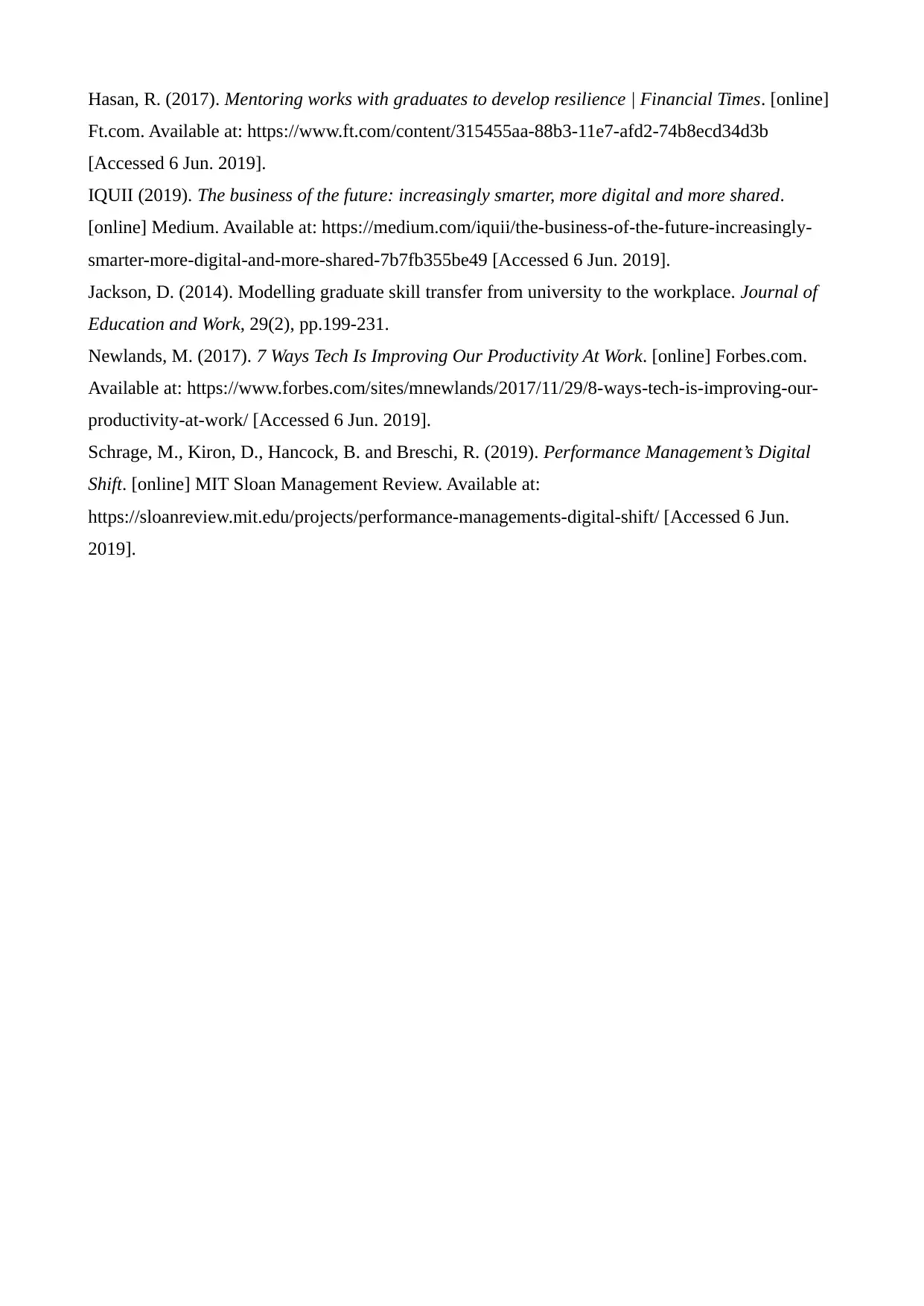
Hasan, R. (2017). Mentoring works with graduates to develop resilience | Financial Times. [online]
Ft.com. Available at: https://www.ft.com/content/315455aa-88b3-11e7-afd2-74b8ecd34d3b
[Accessed 6 Jun. 2019].
IQUII (2019). The business of the future: increasingly smarter, more digital and more shared.
[online] Medium. Available at: https://medium.com/iquii/the-business-of-the-future-increasingly-
smarter-more-digital-and-more-shared-7b7fb355be49 [Accessed 6 Jun. 2019].
Jackson, D. (2014). Modelling graduate skill transfer from university to the workplace. Journal of
Education and Work, 29(2), pp.199-231.
Newlands, M. (2017). 7 Ways Tech Is Improving Our Productivity At Work. [online] Forbes.com.
Available at: https://www.forbes.com/sites/mnewlands/2017/11/29/8-ways-tech-is-improving-our-
productivity-at-work/ [Accessed 6 Jun. 2019].
Schrage, M., Kiron, D., Hancock, B. and Breschi, R. (2019). Performance Management’s Digital
Shift. [online] MIT Sloan Management Review. Available at:
https://sloanreview.mit.edu/projects/performance-managements-digital-shift/ [Accessed 6 Jun.
2019].
Ft.com. Available at: https://www.ft.com/content/315455aa-88b3-11e7-afd2-74b8ecd34d3b
[Accessed 6 Jun. 2019].
IQUII (2019). The business of the future: increasingly smarter, more digital and more shared.
[online] Medium. Available at: https://medium.com/iquii/the-business-of-the-future-increasingly-
smarter-more-digital-and-more-shared-7b7fb355be49 [Accessed 6 Jun. 2019].
Jackson, D. (2014). Modelling graduate skill transfer from university to the workplace. Journal of
Education and Work, 29(2), pp.199-231.
Newlands, M. (2017). 7 Ways Tech Is Improving Our Productivity At Work. [online] Forbes.com.
Available at: https://www.forbes.com/sites/mnewlands/2017/11/29/8-ways-tech-is-improving-our-
productivity-at-work/ [Accessed 6 Jun. 2019].
Schrage, M., Kiron, D., Hancock, B. and Breschi, R. (2019). Performance Management’s Digital
Shift. [online] MIT Sloan Management Review. Available at:
https://sloanreview.mit.edu/projects/performance-managements-digital-shift/ [Accessed 6 Jun.
2019].
1 out of 10
Related Documents
Your All-in-One AI-Powered Toolkit for Academic Success.
+13062052269
info@desklib.com
Available 24*7 on WhatsApp / Email
![[object Object]](/_next/static/media/star-bottom.7253800d.svg)
Unlock your academic potential
Copyright © 2020–2025 A2Z Services. All Rights Reserved. Developed and managed by ZUCOL.





